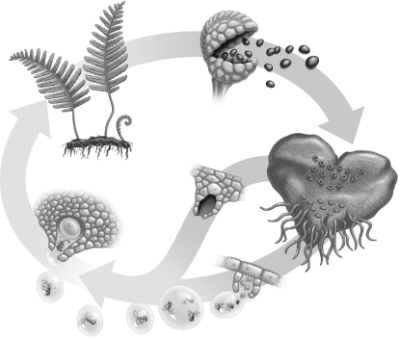A) the diploid chromosome number is reduced to haploid.
B) parental DNA is divided and distributed to forming gametes.
C) offspring are provided with new gene combinations.
D) alternate forms of genes are shuffled.
E) All of the choices are correct.
Correct Answer

verified
Correct Answer
verified
Multiple Choice
During meiosis II
A) cytokinesis results in the formation of a total of two cells.
B) sister chromatids exchange parts.
C) homologous chromosomes synapse.
D) sister chromatids of each chromosome are separated from each other.
E) homologous chromosomes separate.
Correct Answer

verified
Correct Answer
verified
Multiple Choice
Under favorable conditions, during which phase of meiosis will the chromosomes appear as packets of four chromatids?
A) Metaphase II
B) Telophase II
C) Prophase I
D) Anaphase II
E) Anaphase I
Correct Answer

verified
Correct Answer
verified
Multiple Choice
How many haploid cells are produced by one diploid cell during meiosis?
A) Two
B) Four
C) 8 million
D) One
Correct Answer

verified
Correct Answer
verified
Short Answer
About 1 in every 1,000 women has three X chromosomes, a condition known as _ X.
Correct Answer

verified
Correct Answer
verified
Multiple Choice
Sister chromatids are separated from each other during
A) anaphase II.
B) telophase II.
C) metaphase I.
D) anaphase I.
E) metaphase II.
Correct Answer

verified
Correct Answer
verified
Multiple Choice
Sea stars are genetically different from each other and from their parents. These genetic differences are the result of
A) cloning.
B) sexual reproduction.
C) mitosis.
D) asexual reproduction.
Correct Answer

verified
Correct Answer
verified
Multiple Choice
Which of the following distinguishes prophase 1 of meiosis from prophase of mitosis?
A) Spindle forms.
B) Homologous chromosomes pair up.
C) Nuclear membrane breaks down.
D) Chromosomes become visible.
Correct Answer

verified
Correct Answer
verified
Multiple Choice
What is the name of the process depicted below that shows the life cycle of the typical plant? 
A) Mitosis and meiosis
B) Alternation of generations
C) Alternation of genomes
D) Mitosis
E) Meiosis
Correct Answer

verified
Correct Answer
verified
Short Answer
Sperm and egg fuse to form a diploid fertilized egg, called a .
Correct Answer

verified
Correct Answer
verified
Multiple Choice
What is a major difference between mitosis and meiosis?
A) Meiosis produces haploid cells, whereas mitosis produces diploid cells.
B) Meiosis produces genetically identical daughter cells, whereas mitosis produces genetically variable daughter cells.
C) Meiosis produces two daughter cells instead of the four daughter cells produced in mitosis.
D) Mitosis produces daughter cells, whereas meiosis produces parent cells.
Correct Answer

verified
Correct Answer
verified
Multiple Choice
Which of the following cell cycles is represented by birds?
A) Haploid life cycle
B) Alternation of generations
C) Diploid life cycle
Correct Answer

verified
Correct Answer
verified
Multiple Choice
In comparing mitosis and meiosis, which of the following statements is TRUE?
A) Chromatids are present only in mitosis.
B) Meiosis I is more like mitosis than is meiosis II.
C) Synapsis occurs in both.
D) Meiosis II resembles mitosis.
E) Both processes result in four cells.
Correct Answer

verified
Correct Answer
verified
True/False
Crossing over takes place between sister chromatids during prophase I of meiosis I.
Correct Answer

verified
Correct Answer
verified
Multiple Choice
Anaphase
A) involves the lining up of the chromosomes across the equatorial plate.
B) results in an unequal distribution of chromosomes to the resulting cells.
C) is initiated when the newly divided centromeres begin to move apart.
D) is the same in mitosis and meiosis I and II.
Correct Answer

verified
Correct Answer
verified
Multiple Choice
In a haploid daughter cell produced by meiosis, the homologous chromosomes have
A) multiplied.
B) remained attached.
C) mutated.
D) separated.
Correct Answer

verified
Correct Answer
verified
Multiple Choice
Chiasmata (or chiasma) provide evidence of
A) chromosomal aberration.
B) crossing over.
C) spindle fiber formation.
D) fertilization.
E) meiosis.
Correct Answer

verified
Correct Answer
verified
Multiple Choice
Meiosis typically results in the production of
A) four haploid cells.
B) one triploid cell.
C) four diploid cells.
D) two diploid cells.
E) two haploid cells.
Correct Answer

verified
Correct Answer
verified
Multiple Choice
Which of the following cell cycles is represented by ferns and other plants?
A) Haploid life cycle
B) Alternation of generations
C) Diploid life cycle
Correct Answer

verified
Correct Answer
verified
Multiple Choice
Alternative forms of a gene (such as those responsible for eye color) are called
A) cyclins.
B) telomeres.
C) receptors.
D) sister chromatids.
E) alleles.
Correct Answer

verified
Correct Answer
verified
Showing 41 - 60 of 103
Related Exams